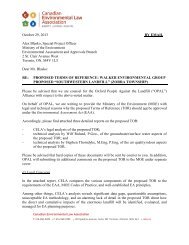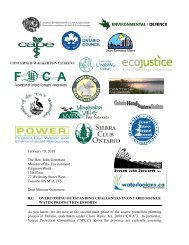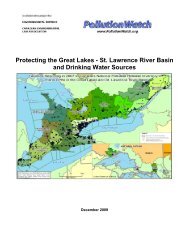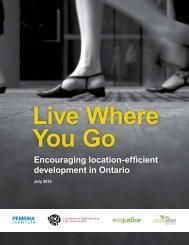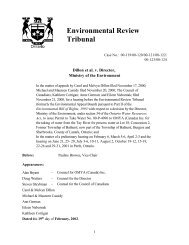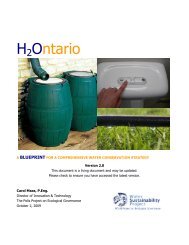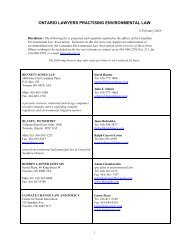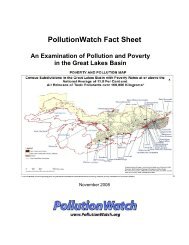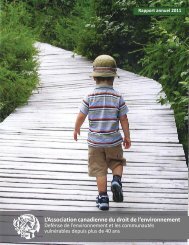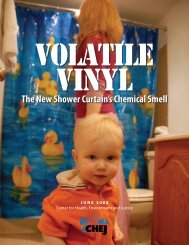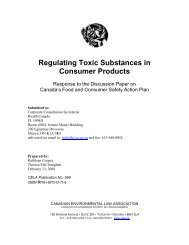Creating Healthy Environments for kids - Canadian Partnership for ...
Creating Healthy Environments for kids - Canadian Partnership for ...
Creating Healthy Environments for kids - Canadian Partnership for ...
Create successful ePaper yourself
Turn your PDF publications into a flip-book with our unique Google optimized e-Paper software.
In<strong>for</strong>mation Supplement<strong>Creating</strong> <strong>Healthy</strong><strong>Environments</strong><strong>for</strong><strong>kids</strong>Toxic substances are common inour environment, both indoors andout. Harmful chemicals that stickto dust, fumes from cleaning andrenovation products, chemicals inplastics, mercury in fish—all of thesecan have serious impacts on thehealth of children. The good news isthat parents can take some simplesteps—beyond what they alreadydo—to reduce risks in the home.Children are at greater risk thanadults because their naturaldefences are not fully developed.Babies and toddlers also explore theworld with their hands and mouths,which exposes them more toharmful substances. This guidewill help parents protecttheir <strong>kids</strong> by offering tips <strong>for</strong>“environmental childproofing.”See inside <strong>for</strong> what to do around your homewww.healthyenvironment<strong>for</strong><strong>kids</strong>.ca
Safeathome5 things you can doto protect your familyRenovate rightDish safer fishWant to create a healthy home environment<strong>for</strong> your children, but don’t know whereto begin? Here are five areas where youcan make an immediate impact with simpleactions—without spending a lot of money.• Children and pregnant women should stayaway from areas being renovated, to avoid beingexposed to potentially harmful substances.• Control and contain all dust. Seal off the rest of thehouse from the renovation site with plastic sheetingand duct tape and close heating and cooling vents.Particularly in older homes (built be<strong>for</strong>e 1978),renovation dust can contain high levels of lead,which is toxic to the developing brain.• Choose less toxic paints, finishes and glues. Look<strong>for</strong> products labeled “VOC-free,” “zero-VOC” or“low-VOC.” Open the windows and use fans to bringin fresh air during and after use of these products.• Choose varieties of fish that are low in mercury,a chemical that is harmful to the brain. Healthierchoices include Atlantic mackerel, herring, rainbowtrout, wild or canned salmon, and tilapia.• If you eat canned tuna, look <strong>for</strong> “light”varieties, as these are lower in mercury thanalbacore or “white” tuna.• If you catch sport fish in local waters, checkyour province’s or territory’s advisories to seewhether it is safe to eat.• Keep your work clothes and shoes in a separatehamper, or in a shed or garage. Wash themseparately from other laundry.Bust that dust• House dust is one of the main sources of children’sexposure to toxic substances, most of which comefrom normal wear-and-tear on consumer products.• Clean with a good quality vacuum, or simply a dampcloth or wet mop. (Dry dusting just circulates thedust back into the air.) Vacuum or wet-mop once aweek; twice a week if you have a crawling child.• Take your shoes off at the door to minimizethe amount of dirt brought inside. Use washableentrance mats, and launder them separatelyfrom clothing.• Reduce the amount of dust in the homeby minimizing clutter and by storing toys inclosed containers.Go greenwhen you clean• Wash your hands often, using regular soap andwarm water: doctors recommend against usingantibacterial soaps.• Use non-toxic cleaning products. Baking sodais a good scouring powder <strong>for</strong> sinks and tubs,and vinegar mixed with water works well <strong>for</strong>windows, surfaces and floors. You don’t need touse bleach <strong>for</strong> most cleaning tasks.• Don’t use air “fresheners.” Also, choose fragrancefreelaundry detergents, and avoid using dryersheets. The fragrances (or “parfum”) in theseproducts can contain potentially harmful chemicals.• Avoid dry cleaning, or find a cleaner that usesnon-toxic methods.• And, of course, keep all cleaners and otherhousehold chemicals out of the reach of children.Get drasticwith plastic• Don’t use plastic containers or plastic wrap inthe microwave, even if the packaging says“microwave-safe.” Harmful chemicals can movefrom the plastic into food and drinks.• Store food in glass or ceramic containers,rather than plastic.• When heating milk, use a non-plastic container.When the liquid has cooled to lukewarm,transfer it to bottles.• Eat fresh or frozen foods whenever possible toreduce exposure to BPA, a chemical used in thelining of most food and drink cans.• Avoid teething toys, bibs, bath toys, showercurtains and other items that contain PVC or vinyl(a type of soft plastic). These items can containharmful chemicals called phthalates, which werebanned in children’s toys in June 2011.Focusing on these five “hot spots”is a great start. For more onkeeping your children safe, visit:www.healthyenvironment<strong>for</strong><strong>kids</strong>.caSee over <strong>for</strong> safe pregnancy tips >>
BetterSafeThanSorryChemicals in dustand cleaning productsor mercury in fishmay not make yourchildren look or feelsick. But exposureto small amounts oftoxic substancescan have long-term,often subtle effectson the developingbrain, lungs, andreproductive systemof a fetus or youngchild. Scientists stilldon’t understandall of these effects.However, when itcomes to children’shealth, it is better tobe safe than sorry.Small amounts ofharmful substancescan add up. But socan your ef<strong>for</strong>ts toreduce everyday exposures,by followingsimple environmentalchildproofing tips likethe “top 5” inside.Head Start:Tips <strong>for</strong> a healthy pregnancyPregnant women can do many things to promote the healthy development of theirbabies, including avoiding tobacco smoke and alcohol. Expectant mothers and theirfamilies can also take steps to reduce exposure to certain harmful substances oftenfound in the home. Scientific evidence shows that exposure, during pregnancy, topollution and toxic chemicals in products can be harmful to child health anddevelopment. Here’s how you can reduce the risks:• Avoid exposure to paint fumes,renovation dust and certain buildingmaterials that can have harmfuleffects during pregnancy.• Eat a healthy diet. Getting enoughcalcium, <strong>for</strong> example, can reduce theamount of lead your body absorbs.• Avoid changing vacuum bags oremptying the bin of a central vacwhen you’re pregnant: householddust can contain many harmfulsubstances. Don’t ask children todo this chore, either.• Choose fish that are low in mercury,minimize risk of food poisoning bynot eating raw fish, and follow localfish advisories.• Avoid using harsh, strong-smellingcleaning products when pregnant,especially those with hazardsymbols on the label. These havebeen linked to wheezing andasthma in children once they reachpreschool age. Some also containchemicals that can affect thebody’s hormones.Breast is best! Experts agree that breastfeeding is the healthiestchoice <strong>for</strong> babies and their mothers. While you’re breastfeeding, makesure you get plenty of rest and eat a healthy diet low in animal fats.For more environmental childproofingin<strong>for</strong>mation and tips, visit:www.healthyenvironment<strong>for</strong><strong>kids</strong>.caThe <strong>Canadian</strong> <strong>Partnership</strong> <strong>for</strong> Children’s Health and Environment (CPCHE) is a collaboration of environmental,public health, child care, and physician organizations that have been working together since 2001 toadvance protection of children’s health from toxic chemicals and pollution. We aim to raise public awarenessand empower individual action, while at the same time calling upon government and businesses to adoptmore protective policies and practices. Together, we can create healthier environments <strong>for</strong> <strong>kids</strong>.This project has received funding support from the Government of Ontario. Such support does not indicateendorsement by the Government of Ontario of the contents of this material.Printed in Canada on 100% post-consumer recycled paper. June 2011. Ce document est également disponible en français.



